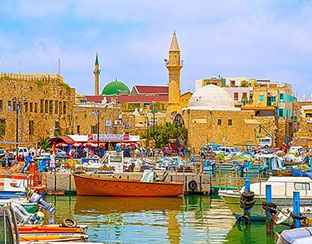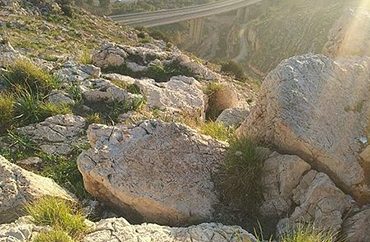Acre (Akko)
Acre: A Place to Experience Multi-Cultural History

Old Acre (Photo: ELIAS MOSHE, CC BY 2.5)
Acre, perhaps one of the most multifaceted towns in Israel, is located on the northern Mediterranean coast. Today, Jews, Christians and Muslims live, study, work and relax side by side painting a picture of harmony for all to experience.
Why the Name Acre?
The origin of its name (in Hebrew, Akko) is not clear, although according to one reason, in the times of Noah, the flood stopped at Acre and so it was named “ad ko,” which means “until here.”
Conquests
Acre is one of the world’s most ancient ports, being at least 4,000 years old. Many conquering armies first entered the Holy Land through Acre. After the division of the Roman Empire, the Byzantines took over the rule of Acre followed by Moslems, Crusaders, Mamluks, Ottomon Turks and the British.
Napoleon’s Embarrassing Defeat
One of the most famous aspects of Acre’s history is the spectacular defeat of Europe’s most famous warrior, Napoleon Bonaparte. In 1799, after laying siege to the city for two months, Napoleon was routed by the combined armies of the Turks and the British. Only recently have archaeologists discovered what probably contributed to his defeat – a large water reservoir under Al Jezaar’s mosque, which presumably helped the inhabitants of the town withstand the siege.
Archaeological Excavations Acre (Akko)
A complete magnificent Crusader city was discovered underground, below street level, in Acre. Excavations started just over 40 years ago and, are still ongoing as there is a tremendous amount still to explore and uncover. These remains show the layout of the medieval Crusader kingdom. It is also an important example of an Ottoman walled town with citadels, mosques and baths, many of which are built on top of Crusader structures. Acre’s fascinating history unfolds for you in both the city above and the excavated Crusader city below.
The Hospitaller Fortress
The Knights of the Hospitaller Order, whose halls you can now visit, were in charge of both healing the sick (hospital) and providing a place for the wayfarers of their order to stay (hospitality). Now you can see the six enormous banqueting halls, a Great Hall with eighteen massive pillars, a dungeon and a dining hall. For many of the knights, this was their resting place before they traveled up to Jerusalem. The imposing arches in the vaulted ceiling have been beautifully preserved and reconstructed and you can see the opulence in which these knights lived. This fortress served as the main defense of Acre during the 11th and 12th centuries.
The Enchanted Garden (The Festival Garden)
This garden area serves as an entrance to the Old Acre Visitors’ Center. The tall, shady trees, cool fountains and plenty of seating are a welcome relief as you come in from the sun outside. You’ll also find restrooms and drink machines here. It’s a great place for a picnic stop on your tour around the city. There are also archaeological finds on exhibit here as well as a chance to view a film about Acre’s turbulent history. To contact the Visitors Center located at 1 Weizmann Street phone: (04) 995-6706.
The Templars Tunnel
Another order of knights, the Knights Templar, who previously served in Jerusalem (guarding the Temple, hence their name) retreated to Acre when they were routed from Jerusalem in the 12th century by Salah a Din.
When they settled into Acre they built themselves an impressive fortress, said to be the strongest fortress in Acre. They also built an escape route, a tunnel that led from the Templar Fortress in the west of the city to the harbor in the east.Extensive excavations have been carried out since then, which have now made the entire route of 1150 feet (350 m) accessible to visitors.
The Citadel
In 1775 the Ottoman ruler Jezaar Pasha rebuilt what was then a relatively small 12th century citadel. He refortified it and turned it into a strong, impenetrable fortress surrounded by a dry moat.
The Underground Prisoners’ Museum
During the time of the British Mandate when the Jewish resistance began to fight for the right to an independent Jewish state, the British turned the Citadel into a prison for housing captured members of the Jewish underground, and hanged several of those Jews in the fortress. In May 1947, the Etzel underground movement smuggled explosives to the inmates and a number of both Jews and Arab prisoners managed to break out of the fortress.
Today this is the site of the Jewish Resistance Fighters Museum. You can visit the museum Sunday to Thursday from 8:30 am to 4:30 pm and Friday: 8:30 am to 1:30 pm. The museum is closed on Saturdays, holiday eves and holidays. For further information email: Email: hmakko_museum@mod.gov.il or phone: 972-4-9911375, 972-4-9811020.
Acre: Did You Know?
Two World Heritage Sites
In July, 2008, the magnificent Bahai Gardens at the northern end of Acre were also declared a World Heritage Site. Admission is free of charge. In 2001, UNESCO declared Acre a World Heritage Site because of the remains of the Crusader town both above and below ground level.











